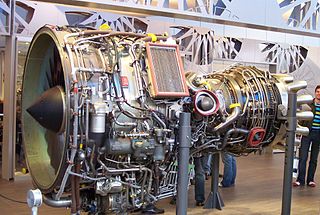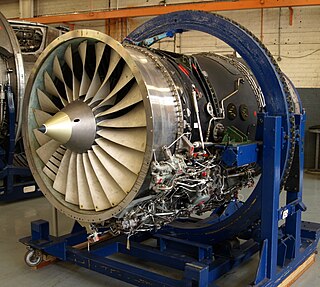
The turbofan or fanjet is a type of airbreathing jet engine that is widely used in aircraft propulsion. The word "turbofan" is a portmanteau of "turbine" and "fan": the turbo portion refers to a gas turbine engine which achieves mechanical energy from combustion, and the fan, a ducted fan that uses the mechanical energy from the gas turbine to force air rearwards. Thus, whereas all the air taken in by a turbojet passes through the combustion chamber and turbines, in a turbofan some of that air bypasses these components. A turbofan thus can be thought of as a turbojet being used to drive a ducted fan, with both of these contributing to the thrust.

The Pratt & Whitney PW2000, also known by the military designation F117 and initially referred to as the JT10D, is a series of high-bypass turbofan aircraft engines with a thrust range from 37,000 to 43,000 lbf. Built by Pratt & Whitney, they were designed for the Boeing 757. As a 757 powerplant, these engines compete with the Rolls-Royce RB211.

The Pratt & Whitney PW6000 is a high-bypass turbofan jet engine designed for the Airbus A318 with a design thrust range of 18,000–24,000 lbf (80–107 kN).

The Turbo-Union RB199 is a turbofan jet engine designed and built in the early 1970s by Turbo-Union, a joint venture between Rolls-Royce, MTU and Aeritalia. The only production application was the Panavia Tornado.

The Rolls-Royce Olympus was the world's second two-spool axial-flow turbojet aircraft engine design, first run in May 1950 and preceded only by the Pratt & Whitney J57, first-run in January 1950. It is best known as the powerplant of the Avro Vulcan and later models in the Concorde SST.

The Rolls-Royce RB.183 Tay is a medium-bypass turbofan engine, developed from the RB.183 Mk 555 Spey core and using a fan scaled directly from the Rolls-Royce RB.211-535E4 to produce versions with a bypass ratio of 3.1:1 or greater. The IP compressor and LP turbine were designed using technology from the RB.211 programme. The engine was first run in August 1984. The Tay 650 had a new HP turbine which incorporated new technology which had been proven with the RB.211-535E4. This engine also had a new combustor for improved durability. The Tay family is used on a number of airliners and larger business jets, including the Gulfstream IV family, Fokker 70 and Fokker 100, with a later version being used to re-engine Boeing 727-100s.

The Rolls-Royce Trent 500 is a high-bypass turbofan produced by Rolls-Royce to power the larger A340-500/600 variants. It was selected in June 1997, first ran in May 1999, first flew in June 2000, and achieved certification on 15 December 2000. It entered service in July 2002 and 524 engines were delivered on-wing until the A340 production ended in 2011.

The Rolls-Royce Trent 700 is a high-bypass turbofan produced by Rolls-Royce plc to power the Airbus A330. Rolls-Royce was studying a RB211 development for the A330 at its launch in June 1987. It was first selected by Cathay Pacific in April 1989, first ran in summer 1992, was certified in January 1994 and was put into service on 24 March 1995. Keeping the characteristic three-shaft architecture of the RB211, it is the first variant of the Trent family. With its 97.4 in (247 cm) fan for a 5:1 bypass ratio, it produces 300.3 to 316.3 kN of thrust and reach an overall pressure ratio of 36:1. It competes with the General Electric CF6-80E1 and the PW4000 to power the A330.

The Rolls-Royce Trent 800 is a high-bypass turbofan produced by Rolls-Royce plc, one of the engine options for the early Boeing 777 variants. Launched in September 1991, it first ran in September 1993, was granted EASA certification on 27 January 1995, and entered service in 1996. It reached a 40% market share, ahead of the competing PW4000 and GE90, and the last Trent 800-powered 777 was delivered in 2010. The Trent 800 has the Trent family three shaft architecture, with a 280 cm (110 in) fan. With a 6.4:1 bypass ratio and an overall pressure ratio reaching 40.7:1, it generates up to 413.4 kN of thrust.

The Rolls-Royce Trent 900 is a high-bypass turbofan produced by Rolls-Royce plc to power the Airbus A380, competing with the Engine Alliance GP7000. Initially proposed for the Boeing 747-500/600X in July 1996, this first application was later abandoned but it was offered for the A3XX, launched as the A380 in December 2000. It first ran on 18 March 2003, made its maiden flight on 17 May 2004 on an A340 testbed, and was certified by the EASA on 29 October 2004. Producing up to 374 kN (84,000 lbf), the Trent 900 has the three shaft architecture of the Rolls-Royce Trent family with a 2.95 m (116 in) fan. It has a 8.5–8.7:1 bypass ratio and a 37–39:1 overall pressure ratio.

The Bristol Orion aero engine was a two-shaft turboprop intended for use in later marks of the Bristol Britannia and the Canadair CL-44. Although the engine was built and underwent a development program, the BE.25 Orion project was cancelled in 1958 by the British Ministry of Supply in favour of the Rolls-Royce Tyne. In addition, interest in turboprop-powered aircraft was beginning to wane, because of the successful introduction of the Boeing 707 and Douglas DC-8 jetliners into airline service.
The Rolls-Royce/JAEC RJ500 was a 20,000 lbf (89 kN) civil turbofan which Rolls-Royce and the Japanese Aero Engine Corporation (JAEC) consortium hoped to develop for aircraft like the Boeing 737-300 and the McDonnell Douglas MD-80.

The Bristol Siddeley BS.100 is a British twin-spool, vectored thrust, turbofan aero engine that first ran in 1960. The engine was designed and built in limited numbers by Bristol Siddeley Engines Limited. The project was cancelled in early 1965.

The Rolls-Royce RB.93 Soar, also given the Ministry of Supply designation RSr., was a small, expendable British axial-flow turbojet intended for cruise missile use and built by Rolls-Royce Limited in the 1950s and 1960s. Like all the company's gas turbine engines it was named after a British river, in this case, the River Soar.

The NK-8 was a low-bypass turbofan engine built by the Kuznetsov Design Bureau, in the 90 kN (20,000 lbf) thrust class. It powered production models of the Ilyushin Il-62 and the Tupolev Tu-154A and B models.

The Progress D-18T is a 51,500 lbf (229 kN) high-bypass turbofan that powers the Antonov An-124 Ruslan and An-225 large freighters.

The Rolls-Royce RB.141 Medway was a large low-bypass turbofan engine designed, manufactured and tested in prototype form by Rolls-Royce in the early-1960s. The project was cancelled due to changes in market requirements that also led to the development and production of the smaller but similar Rolls-Royce Spey, and the cancellation of the Armstrong Whitworth AW.681 military transport aircraft project.

The Rolls-Royce/MAN Turbo RB.193 is a vectored thrust turbofan engine designed and manufactured by Rolls-Royce and MAN Turbo in the mid-1960s. The engine test flew in its sole application, the VFW VAK 191B VTOL fighter aircraft but production did not follow after cancellation of the associated aircraft project.

The Rolls-Royce RB.145 was a British jet engine designed in the early-1960s by Rolls-Royce for use as a lightweight VTOL lift and cruise engine. Developed from the Rolls-Royce RB108 the RB.145 featured more accessories and a higher thrust rating. Six engines developed by MAN Turbo were fitted to the first prototype of the EWR VJ 101 experimental German fighter aircraft, achieving supersonic flight by July 1964.

The Rolls-Royce RB.203 Trent was a British medium-bypass turbofan engine of around 10,000lb thrust designed for production in the late 1960s, bearing no relation to the earlier Rolls-Royce RB.50 Trent turboprop or the later high-bypass Rolls-Royce Trent turbofan.



















